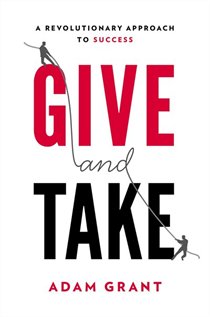Giving vs. Taking
Michael Gottwald, Carl Kriss & Josh Penn
Does embracing a sense of service to others move people towards action more effectively than material rewards? That is one question psychology professor Adam Grant explores in his new book, Give and Take, that sheds light on a new form of motivation that focuses more on giving than taking. In the New York Times article, Is Giving the Secrete to Getting Ahead, Susan Dominus writes about how Grant discovered that creating a culture of giving leads to productivity at a call center. “Given that one of the center’s primary purposes was funding scholarships, Grant brought in a student who had benefited from that fund-raising. The callers took a 10-minute break as the young man told them how much the scholarship had changed his life…A month after the testimonial, the workers were spending 142 percent more time on the phone and bringing in 171 percent more revenue.”
This reflects the power of a principle that was practiced effectively on the Obama campaign that originally comes from the President’s original mentor in community organizing, Marshall Ganz: sharing your story. Every community organizer was taught the importance of letting potential volunteers and voters know why he or she was personally motivated to work for the President’s campaign, in the form of a story. Volunteers were encouraged to share as well. Online content would reflect this emphasis on personal stories. Online and offline, the Obama campaign was able to install a “higher sense of service” in order to grow their grassroots army of volunteers and set historic fundraising numbers. Here is a video the campaign sent in an email blast to supporters during the 2008 campaign.
In the video, a donor named Greg Smith starts to get teary eyed as he explains how his mom left for Jamaica and almost was not allowed to bring Greg and his sister to America because of immigration laws. Greg explains, “Mr. Obama’s stance is that you can’t separate families… I think my fulfillment as a human being is only coming into play because of that fact that I was reconnected with my mom and able to now take part of the American dream.” Greg’s sincerity is very moving and turns the action of donating to a political campaign into the greater idea of investing in the American dream.
This leads us to ask if you can make a movie that is more than just a film. Similar to how the Obama campaign became more than just a campaign by inspiring supporters to remember the importance of community and empowering others. Can a film campaign also start to embody an idea greater than itself and motivate people to act? Are only issue related films able to spark a movement, or can non-issue films also go beyond just being a film? Already, those at Kickstarter will encourage potential fundraisers to do the equivalent of “share their story” in their videos.
This lessons of the campaign and the experiment mentioned in the Times could lead us to two possible answers to these questions. 1) If filmmakers shape the message of their fundraising efforts towards a higher purpose related to the issue or themes in their movie they are more likely to motivate people to contribute. 2) If filmmakers don’t have a higher purpose to their film, just being upfront and personal with why he or she wants to make that film (and what it means to them) can be a powerful tool.
-Josh, Michael and Carl

